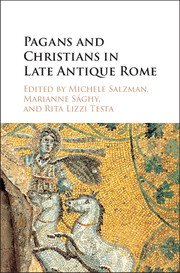 Pagans and Christians in Late Antique Rome
Pagans and Christians in Late Antique Rome from Section B - Death and the Afterlife
Published online by Cambridge University Press: 05 November 2015
The so-called circiform funerary basilicas in Rome represent one of the most easily identifiable of all Roman building types. In plan the edifices resemble a circus, as suggested by the oblique short eastern wall that imitates the angle of the circus carceres, a feature that is not determined by topography and that has no utility (Figure 13.1). Side aisles formed an ambulatory around an apsed nave on the inside, and all were roofed, likely with a clerestory. Six are known to date, and all are located on consular roads at roughly the same distance from the city (Figure 13.2). Starting from the northeast, they include S. Agnese on Via Nomentana with the mausoleum attributed to Constantine's daughter Constantina, S. Lorenzo by Via Tiburtina, found under the cemetery Campo Verano, the basilica in the Villa dei Gordiani on Via Praenestina with the mausoleum called Tor de'Schiavi, SS. Pietro e Marcellino on Via Labicana with the mausoleum of Constantine's mother Helena, and S. Sebastiano, or the Basilica Apostolorum, on Via Appia. The discovery of a sixth basilica by Via Ardeatina in the 1990s increases the likelihood that similar edifices were raised on further spokes, such as Via Salaria or Via Ostiense. Their dates and functions are disputed, but scholars generally agree that they all were erected in the first two quarters of the fourth century, and that they functioned primarily as covered graveyards, coemeteria coperta, because their internal surfaces were paved with tombstones, and once built, mausolea and catacomb galleries emerged at their sites. The period of their use was relatively brief; all save the Via Appia basilica, which was preserved through its post-antique association with Saint Sebastian, fell to ruin by the late-seventh and eighth centuries. No circiform basilica has been found outside Rome.
Most scholars discuss the circiform basilicas in the context of Constantine's church-building projects, and the Labicana, Nomentana, and Tiburtina basilicas are mentioned in the Liber Pontificalis, with the Ardeatina a possible fourth. Although Constantine was certainly involved with most of these structures, the construction of one, possibly two, of the edifices – the Praenestina and Appia basilicas – was in all likelihood already begun before his conquest of Rome. This suggests that we need to explain the conception of the building type without regard for Constantine's open support for Christianity after 312.
To save this book to your Kindle, first ensure no-reply@cambridge.org is added to your Approved Personal Document E-mail List under your Personal Document Settings on the Manage Your Content and Devices page of your Amazon account. Then enter the ‘name’ part of your Kindle email address below. Find out more about saving to your Kindle.
Note you can select to save to either the @free.kindle.com or @kindle.com variations. ‘@free.kindle.com’ emails are free but can only be saved to your device when it is connected to wi-fi. ‘@kindle.com’ emails can be delivered even when you are not connected to wi-fi, but note that service fees apply.
Find out more about the Kindle Personal Document Service.
To save content items to your account, please confirm that you agree to abide by our usage policies. If this is the first time you use this feature, you will be asked to authorise Cambridge Core to connect with your account. Find out more about saving content to Dropbox.
To save content items to your account, please confirm that you agree to abide by our usage policies. If this is the first time you use this feature, you will be asked to authorise Cambridge Core to connect with your account. Find out more about saving content to Google Drive.